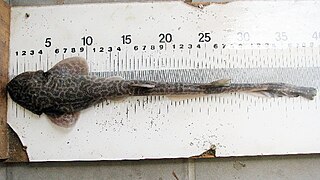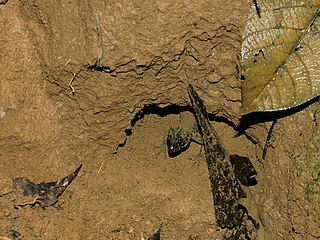Related Research Articles

Lepidophyma is a genus of lizards, commonly called tropical night lizards. The genus Lepidophyma is one of three genera of night lizards, which are a group of viviparous (live-bearing) lizards. There are 20 species of tropical night lizards in the genus Lepidophyma, making it the most populous night lizard genus. Species of the genus Lepidophyma are distributed throughout Central America, found anywhere from central Mexico to Panama, depending on the particular species. Tropical night lizards, particularly the yellow-spotted species, are sometimes called Central American bark lizards by pet dealers and owners.

Night lizards are a group of small scincomorph lizards, averaging from less than 4 cm (1.6 in) to over 12 cm (4.7 in) snout–vent length. Most species are viviparous (live-bearing), with the exception of those in the genus Cricosaura. The family has only three living genera, with approximately 34 living species. The genera are divided by geographic range: Xantusia in southwestern North America and Baja California, Cricosaura in Cuba, and Lepidophyma, the most populous night lizard genus, in Central America. Three fossil genera are also known: Catactegenys, Palepidophyma, Palaeoxantusia.

Plesiosaurus is a genus of extinct, large marine sauropterygian reptile that lived during the early part of the Jurassic Period, and is known by nearly complete skeletons from the Lias of England. It is distinguishable by its small head, long and slender neck, broad turtle-like body, a short tail, and two pairs of large, elongated paddles. It lends its name to the order Plesiosauria, of which it is an early, but fairly typical member. It contains only one species, the type, Plesiosaurus dolichodeirus. Other species once assigned to this genus, including P. brachypterygius, P. guilielmiiperatoris, and P. tournemirensis have been reassigned to new genera, such as Hydrorion, Seeleyosaurus and Occitanosaurus.
Sommer's Sulawesi rat is a species of rodent in the family Muridae from Sulawesi. It is the only species in the monotypic genus Sommeromys and was described by Musser & Durden in 2002.

Meloidogyne incognita, also known as the "southern root-nematode" or "cotton root-knot nematode" is a plant-parasitic roundworm in the family Heteroderidae. This nematode is one of the four commonest species worldwide and has numerous hosts. It typically incites large, usually irregular galls on roots as a result of parasitism.

The thorntail stingray, black stingray, or longtail stingray is a species of stingray in the family Dasyatidae. It is found off southern Africa, Australia, and New Zealand from the intertidal zone to a depth of 440 m (1,440 ft). This bottom-dweller inhabits soft-bottomed habitats such as lagoons, estuaries, and reefs. Growing to 1.8 m (5.9 ft) across and over 200 kg (440 lb) in weight, the thorntail stingray is among the largest stingrays in the world. Uniformly dark above and light below, it has a diamond-shaped pectoral fin disc and a very long, whip-like tail with a fin fold underneath. The upper surface of the disc and the tail bear numerous stout, sharp thorns.

The short-tail stingray or smooth stingray is a common species of stingray in the family Dasyatidae. It occurs off southern Africa, typically offshore at a depth of 180–480 m (590–1,570 ft), and off southern Australia and New Zealand, from the intertidal zone to a depth of 156 m (512 ft). It is mostly bottom-dwelling in nature and can be found across a range of habitats from estuaries to reefs, but also frequently will swim into open water. The largest stingray in the world, this heavy-bodied species can grow upwards of 2.1 m (6.9 ft) across and 350 kg (770 lb) in weight. Its plain-colored, diamond-shaped pectoral fin disc is characterized by a lack of dermal denticles even in adults, and white pores beside the head on either side. The body can have colors as well as dark grey or black with rows of white spots along each wing. Its tail is usually shorter than the disc and thick at the base. It is armed with large tubercles and a midline row of large thorns in front of the stinging spine which has the dorsal and ventral fin folds behind.

The Izak catshark or simply Izak is a species of catshark, belonging to the family Scyliorhinidae, common off the coasts of South Africa and southern Namibia. It typically inhabits the outer continental shelf at depths of 100–300 m (330–980 ft), with the males found deeper than the females and juveniles. The Izak catshark has a short, wide, flattened head and a robust body tapering to a long, slender tail. It can be identified by its ornate color pattern of dark brown spots or reticulations and blotches on a light yellowish background, as well as by the enlarged dermal denticles over its pectoral fins and along its dorsal midline from the snout to the second dorsal fin. This species reaches 69 cm (27 in) in length, with the males larger than females.
Belonolaimus longicaudatus is a common parasite of grasses and other plant crops and products. It is the most destructive nematode pest of turf grass, and it also attacks a wide range of fruit, vegetable, and fiber crops such as citrus, cotton, ornamentals, and forage. The sting nematode is a migratory ectoparasite of roots. It is well established in many golf courses and presents a problem in turf management. The sting nematode is only present in very sandy soils. It cannot reproduce in heavier or clay soils.
Rotylenchulus reniformis, the reniform nematode, is a species of parasitic nematode of plants with a worldwide distribution in the tropical and subtropical regions.

Meloidogyne arenaria is a species of plant pathogenic nematodes. This nematode is also known as the peanut root knot nematode. The word "Meloidogyne" is derived from two Greek words that mean "apple-shaped" and "female". The peanut root knot nematode, M. arenaria is one of the "major" Meloidogyne species because of its worldwide economic importance. M. arenaria is a predominant nematode species in the United States attacking peanut in Alabama, Florida, Georgia, and Texas. The most damaging nematode species for peanut in the USA is M. arenaria race 1 and losses can exceed 50% in severely infested fields. Among the several Meloidogyne species that have been characterized, M. arenaria is the most variable both morphologically and cytologically. In 1949, two races of this nematode had been identified, race 1 which reproduces on peanut and race 2 which cannot do so. However, in a recent study, three races were described. López-Pérez et al (2011) had also studied populations of M. arenaria race 2, which reproduces on tomato plants carrying the Mi gene and race 3, which reproduces on both resistant pepper and tomato.
Helicotylenchus multicinctus is a plant pathogenic nematode that affects primarily bananas and plantains. Nematodes of the genus Helicotylenchus are spiral nematodes and feed on a large variety of plant species.
Mesocriconema xenoplax is a species of plant parasitic nematodes. Nematodes of this particular species are collectively called ring nematodes.
Dichelyne alatae is a species of nematode, described on the basis of the worms recovered from the intestine of the whiting, Sillaginopsis panijus from the estuary of the Hooghly River at Kalyani, West Bengal, India. Dichelyne alatae is unique in having a small body size, deirids posterior to the oesophagus, short and wide caudal alae at the level of cloacal opening, unequal, alate spicules, a shield-shaped gubernaculum, a different number of caudal papillae and a conical tail with spines in its distal region.

The nematodes or roundworms constitute the phylum Nematoda, with plant-parasitic nematodes being known as eelworms. They are a diverse animal phylum inhabiting a broad range of environments. Taxonomically, they are classified along with insects and other moulting animals in the clade Ecdysozoa, and unlike flatworms, have tubular digestive systems with openings at both ends. Like tardigrades they have a reduced number of Hox genes, but as their sister phylum Nematomorpha has kept the ancestral protostome Hox genotype, it shows that the reduction has occurred within the nematode phylum.

Trimerorhachis is an extinct genus of dvinosaurian temnospondyl within the family Trimerorhachidae. It is known from the Early Permian of the southwestern United States, with most fossil specimens having been found in the Texas Red Beds. The type species of Trimerorhachis, T. insignis, was named by American paleontologist Edward Drinker Cope in 1878. Cope named a second species from Texas, T. mesops, in 1896. The species T. rogersi and T. greggi are also from Texas, and the species T. sandovalensis is from New Mexico.
Calomys cerqueirai is a species of rodent in the genus Calomys from southeastern Brazil. Distinct from other Calomys in its karyotype and characters of the fur, it is known only from two places in Minas Gerais. The karyotype was first described in 1996 and the species was formally named in 2010.
Falcaustra tannaensis is the 87th discovered species of the nematode genus Falcaustra. It has been identified in geckos from Tanna Island, Vanuatu. Species of Falcaustra have been known parasites that occur in the digestive tracts of fish, amphibians, and mammals. Until 2010, none had ever been identified in the South Pacific Islands.

The yellow-spotted tropical night lizard or yellow-spotted night lizard is a species of night lizard. It is distributed from central Mexico through the Central America south to Panama. It includes four subspecies:
Dianopachysaurus is an extinct genus of pachypleurosaur known from the lower Middle Triassic of Yunnan Province, southwestern China. It was found in the Middle Triassic Lagerstatte of the Guanling Formation. It was first named by Jun Liu, Olivier Rieppel, Da-Yong Jiang, Jonathan C. Aitchison, Ryosuke Motani, Qi-Yue Zhang, Chang-Yong Zhou and Yuan-Yuan Sun in 2011 and the type species is Dianopachysaurus dingi, thanking a Professor Ding for his help.
References
- ↑ Bursey, Charles R; Stephen R. Goldberg; Sam R. Telford, Jr (2006). "New species of Aplectana (Nematoda: Cosmocercidae) and Mesocoelium monas (Digenea: Brachycoeliidae) in Lepidophyma flavimaculatum (Squamata: Xantusiidae) from Costa Rica" (PDF). Caribbean Journal of Science. 42 (2): 164–170. Retrieved 16 October 2012.
| | This Chromadorea nematode (or roundworm-) related article is a stub. You can help Wikipedia by expanding it. |